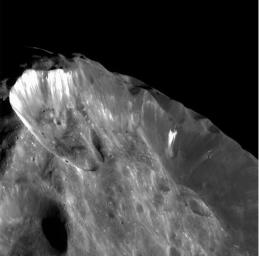Images like this one, showing bright wispy streaks thought to be ice revealed by subsidence of crater walls, are leading to the view that Phoebe is an ice-rich body overlain with a thin layer of dark material. Obvious down slope motion of material occurring along the walls of the major craters in this image is the cause for the bright streaks, which are over-exposed here. Significant slumping has occurred along the crater wall at top left.
The slumping of material might have occurred by a small projectile punching into the steep slope of the wall of a pre-existing larger crater. Another possibility is that the material collapsed when triggered by another impact elsewhere on Phoebe. Note that the bright, exposed areas of ice are not very uniform along the wall. Small craters are exposing bright material on the hummocky floor of the larger crater.
Elsewhere on this image, there are local areas of outcropping along the larger crater wall where denser, more resistant material is located. Whether these outcrops are large blocks being exhumed by landslides or actual 'bedrock' is not currently understood.
The crater on the left, with most of the bright streamers, is about 45 kilometers (28 miles) in diameter, front to back as viewed. The larger depression in which the crater sits is on the order of 100 kilometers (62 miles) across. The slopes from the rim down to the hummocky floor are approximately 20 kilometers (12 miles) long; many of the bright streamers on the crater wall are on the order of 10 kilometers (6 miles) long. A future project for Cassini image scientists will be to work out the chronology of slumping events in this scene.
This image was obtained at a phase, or Sun-Phoebe-spacecraft, angle of 78 degrees, and from a distance of 11,918 kilometers (7,407 miles). The image scale is approximately 70 meters (230 feet) per pixel. No enhancement was performed on this image.
The Cassini-Huygens mission is a cooperative project of NASA, the European Space Agency and the Italian Space Agency. The Jet Propulsion Laboratory, a division of the California Institute of Technology in Pasadena, manages the Cassini-Huygens mission for NASA's Office of Space Science, Washington, D.C. The Cassini orbiter and its two onboard cameras, were designed, developed and assembled at JPL. The imaging team is based at the Space Science Institute, Boulder, Colo.
For more information, about the Cassini-Huygens mission visit, http://saturn.jpl.nasa.gov and the Cassini imaging team home page, http://ciclops.org.

 Planetary Data System
Planetary Data System












